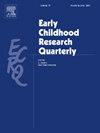背景很重要:调查分层模型中的随机效应对幼儿教育研究人员的重要性
IF 3.2
1区 教育学
Q1 EDUCATION & EDUCATIONAL RESEARCH
引用次数: 0
摘要
本文强调了在幼儿教育研究中同时研究个人、班级和学校层面变量的重要性。众所周知,在以学校为基础的研究中,层次线性建模(HLM)可用于解释教室或学校内学生的聚类情况,但鲜为人知的是,层次线性建模可使用随机效应来研究较高层次的因素(如因学校而异的效应)如何调节较低层次因素之间的关联。即使没有收集到更高层次的数据,也可以检测到这种可能的调节作用。尽管 HLM 的使用非常重要,但对于儿童早期教育研究人员来说,还没有一个明确的资源来解释如何测试这类效应。本文利用幼儿教育实证数据,通过三个分析示例,展示了 HLM 的应用。首先,我们回顾了学校层面的效应文献和 HLM 概念,为在教育研究中测试跨层面的调节效应提供了理论依据;接下来,我们对三个例子中将使用的变量(即:教师信念和学生的社会心理健康)进行了简短的文献回顾、接下来,我们将对三个例子中使用的变量(即教师信念和学生的社会情感行为)的相关文献进行简短回顾;接下来,我们将描述将要分析的数据集;最后,我们将引导读者逐步完成分析,以显示教师信念对学生社会结果的固定效应的存在与否,以及如果在分析中排除学校层面的调节效应(即随机效应)检验,可能会出现的错误结论。本文证明了检验教师和学生如何因学校差异而相互影响的重要性,展示了如何做到这一点,并强调了在教育模型中检验集群随机效应的必要性,以确保在预测学生结果时考虑到全部背景。本文章由计算机程序翻译,如有差异,请以英文原文为准。
Context matters: The importance of investigating random effects in hierarchical models for early childhood education researchers
This paper highlights the importance of examining individual, classroom, and school-level variables simultaneously in early childhood education research. While it is well known that Hierarchical Linear Modeling (HLM) in school-based studies can be used to account for the clustering of students within classrooms or schools, less known is that HLM can use random effects to investigate how higher-level factors (e.g., effects that vary by school) moderate associations between lower-level factors. This possible moderation can be detected even if higher-level data are not collected. Despite this important use of HLM, a clear resource explaining how to test this type of effect is not available for early childhood researchers. This paper demonstrates this use of HLM by presenting three analytic examples using empirical early childhood education data. First, we review school-level effects literature and HLM concepts to provide the rationale for testing cross-level moderation effects in education research; next we do a short review of literature on the variables that will be used in our three examples (viz., teacher beliefs and student socioemotional behavior); next we describe the dataset that will be analyzed; and finally we guide the reader step-by-step through analyses that show the presence and absence of fixed effects of teacher beliefs on student social outcomes and the erroneous conclusions that can occur if school-level moderation (i.e., random effects) tests are excluded from analyses. This paper provides evidence for the importance of testing for how teachers and students impact each other as a function of school differences, shows how this can be accomplished, and highlights the need to examine random effects of clustering in educational models to ensure the full context is accounted for when predicting student outcomes.
求助全文
通过发布文献求助,成功后即可免费获取论文全文。
去求助
来源期刊

Early Childhood Research Quarterly
Multiple-
CiteScore
7.00
自引率
8.10%
发文量
109
期刊介绍:
For over twenty years, Early Childhood Research Quarterly (ECRQ) has influenced the field of early childhood education and development through the publication of empirical research that meets the highest standards of scholarly and practical significance. ECRQ publishes predominantly empirical research (quantitative or qualitative methods) on issues of interest to early childhood development, theory, and educational practice (Birth through 8 years of age). The journal also occasionally publishes practitioner and/or policy perspectives, book reviews, and significant reviews of research. As an applied journal, we are interested in work that has social, policy, and educational relevance and implications and work that strengthens links between research and practice.
 求助内容:
求助内容: 应助结果提醒方式:
应助结果提醒方式:


